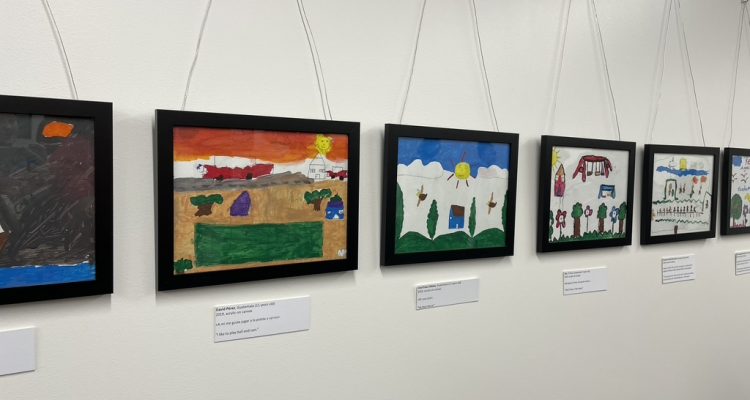“Painting the Border: A Child’s Voice,” an art exhibit that tells the stories of young migrant children, is currently on display here at Fairfield. The artwork currently hangs in the Dimenna-Nyselius Library, the fourth place this exhibit has visited.
I was fortunate enough to see the exhibit for myself and attend the opening lecture, conducted by the university’s Center for Social Impact and guest speaker, Diana Barnes, Ph.D. Barnes is a professor of Spanish at Skidmore College and has done extensive work with migrant children on the U.S. – Mexico border.
In her Lecture, she shared the origins of this exhibit as well as much of her work in helping migrants. Starting as an event put together by Barnes, in collaboration with World Peace Organization representative and author, Lucero de Alva, this project was meant to offer some fun for some of the youngest migrants in a safe space. “Painting the Border” has given a voice to these young children affected by the border crisis. These 32 children who participated were among the 71,000 people stranded in Mexican border cities from 2019 to 2021. In these paintings, they share their stories.
In her lecture, Barnes explained that the children were given one prompt as guidance of what to paint. That prompt was this: “What do you think about the border?”
As I walked through the exhibit, I found many different answers to this prompt in these children’s paintings. One painting by Alejandra Larios Morales, Guatemala (12-years-old) depicts a heart, one half black with the letter “G” painted on it, the other red, with the letter “M.” The caption of this painting reads, “Confusion, confusion. The black heart represents sadness for my mom who is still in Guatemala, ‘G.’ And the red heart represents the happiness that I have being in Mexico.” Another painting, by David Pérez, Guatemala (11-years-old), depicts a driving bus and the caption reads: “The bus with migrants. I like pizza. I don’t like Fanta.”
No matter what was in the painting, there was honesty in these children’s stories and experiences. Each child paints with a unique take on the prompt. Some paint pictures of the wall, expressing their negative feelings toward it. Others paint their houses or beautiful landscapes, describing their likes and dislikes. Some, such as the painting of the heart, take on a more metaphorical meaning. No matter what is painted, we see that the border has affected each and every child involved in the project.
One painting in particular that caught my eye, and that ended up being the topic of discussion later, was a painting by Brithany Paula Hernández, Ciudad Juárez (18-years-old). Brithany’s painting clearly depicts a wall, one side full of people trying to cross a river, the other side lined with green grass and a looming city in the background. In this painting, we see people struggling to swim across this river as well as violence and death on the other side of the border. The caption of this painting reads, “My drawing represents Mexicans trying to get to a better place in their lives, but what is sad is that there are people who discriminate against them, mentally ill people, who are killing them.”
After we had all viewed this painting, we were broken up into small groups to discuss its implications. The Community Advocate and Relationship Educators (CARE) Team did an excellent job in leading us in a discussion about borders, perspective and immigration. I had the chance to share my own perspectives on the painting as well as hear new perspectives from the rest of the group. We discussed borders in our own lives as well as what we can do to cross borders to help others.
It was eye-opening to hear the voices of young children in these paintings. It amazed and saddened me to know that even at a young age, these children are aware of what is going on. Too young to even know of the policy that affects immigration, these children are aware of the inequities and discrimination they are faced with.
After this civic reflection, Barnes openly and honestly shared her work with migrants at the U.S. – Mexico border. She shared her personal experiences in helping migrants on the border as well as many horror stories of the mistreatment of migrants in shelters.
What really struck me about Barnes’ lecture was when she explained that the children were astonished that their stories could cross the border but they could not. In this project, Barnes has made it her mission to be the guardian of these children’s stories, sharing them and educating others on the border crisis.
When we view this exhibit and enter the minds of young children who have been affected by the border crisis, we become the guardians of their stories as well. With that, I encourage each and every Fairfield University student to experience and reflect upon this beautiful exhibit of migrant children’s stories, dreams, hopes and fears. “Painting the Border” will remain in the Library until Dec. 17.


Leave a Reply